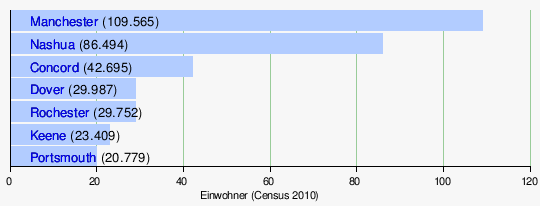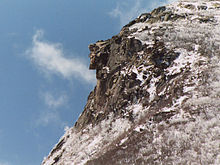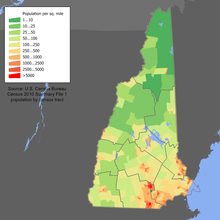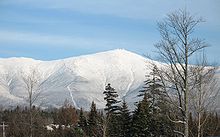New Hampshire
![]()
The title of this article is ambiguous. For other meanings, see New Hampshire (disambiguation).
New Hampshire (![]()
![]() [nuː ˈhæmpʃɚ] AE / [njuː ˈhæmpʃə] BE) is a state of the United States in the New England region. It is bordered by the state of Vermont to the west, Maine to the east, Massachusetts to the south, and the Canadian province of Quebec to the north. With an area of 24,216 km², the state has about 1.3 million inhabitants. The majority of the population lives in the south of the state, the north is dominated by low mountain ranges. The capital is Concord with almost 43,000 inhabitants, but the largest city is Manchester with 110,000.
[nuː ˈhæmpʃɚ] AE / [njuː ˈhæmpʃə] BE) is a state of the United States in the New England region. It is bordered by the state of Vermont to the west, Maine to the east, Massachusetts to the south, and the Canadian province of Quebec to the north. With an area of 24,216 km², the state has about 1.3 million inhabitants. The majority of the population lives in the south of the state, the north is dominated by low mountain ranges. The capital is Concord with almost 43,000 inhabitants, but the largest city is Manchester with 110,000.
The first traces of human settlement date back more than 10,000 years. The vast majority of the population is of European descent; Indians have been sporadic since the 1740s. Contact with Europeans led to heavy population losses among the Native Americans from the 1630s onward, primarily due to smallpox epidemics; eventually, battles with the Iroquois and English drove the survivors to Maine and Canada.
Since 1629 England acted as a colonial power, the colony was named after the English Hampshire. According to the principles of English feudalism, the land was granted and settlers were appointed. In the years from 1641 to 1679 New Hampshire belonged to Massachusetts, was thereupon for two decades directly subject to the king, and from 1691 to 1741 came again to Massachusetts, whose governors became responsible for the northern neighbor.
In 1776, New Hampshire became the first colony to establish a government and adopt a constitution, becoming independent with the newly formed United States. In 1808 Concord became its capital. An independent republic existed on the Canadian border from 1832 to 1835; Great Britain did not relinquish its claims until 1836. The state benefited economically from industrialization and the Civil War, but major industries collapsed with the Great Depression. Only the connection to the Boston economic area brought new industries, especially to southern New Hampshire.
The state is also called The Granite State because of its quarries. At the same time, the nickname also reflects the preservation of traditions and a history of frugal government. There are no general value-added or income taxes, in keeping with the state's motto of "Live Free or Die.
Geography
See also: List of rivers in New Hampshire
Location, extent and structure
New Hampshire is one of the New England states.
New Hampshire's most notable areas are the Great North Woods, the White Mountains, the Lakes Region, the Seacoast Region, the Merrimack Valley, where most residents live, the Monadnock Region, and the Dartmouth-Lake Sunapee Region.
The White Mountains are a sub-mountain range of the Appalachians and cover the northern part of New Hampshire. The highest mountain of the mountains and the third largest of the Appalachians is Mount Washington with 1917 m. Mount Washington is one of the coldest regions in the United States, except for Alaska. When in autumn temperatures of over 0 °C are measured in the valley, it is often already -40 °C there.
In the rather flatter southwest of the state, the most prominent mountain is Mount Monadnock.
The most important rivers are the 177 km long Merrimack River, which flows through New Hampshire from north to south and continues into Massachusetts. Its most important tributaries are the Contoocook River, the Pemigewasset River and the Winnipesaukee River, the 670 km long Connecticut River forms the western border with Vermont and flows further south through the states of Massachusetts and Connecticut. What makes it special is that the state border is not the middle of the Connecticut River, but New Hampshire owns the entire river. The Piscataqua River flows into the Atlantic Ocean, and there are several ports there, including Portsmouth. New Hampshire has an ongoing border dispute with Maine over some islands (now known as Seavey Island), this includes the Portsmouth Navy Yard.
The largest lake is Lake Winnipesaukee, which covers 186 square miles and is located in central New Hampshire.
Landscape
New Hampshire is the second most forested of the 50 U.S. states in percentage terms, after its eastern neighbor Maine.
counties, cities, towns, population distribution
The largest towns are:

- List of cities in New Hampshire
- List of counties in New Hampshire

On May 3, 2003, the Old Man of the Mountain was destroyed by a natural rockfall.

Population density

Mount Washington
Population
| Population development | |||
| Census | Inhabitants | ± in % | |
| 1790 | 141.885 | - — | |
| 1800 | 183.858 | 29,6 % | |
| 1810 | 214.460 | 16,6 % | |
| 1820 | 244.155 | 13,8 % | |
| 1830 | 269.328 | 10,3 % | |
| 1840 | 284.574 | 5,7 % | |
| 1850 | 317.976 | 11,7 % | |
| 1860 | 326.073 | 2,5 % | |
| 1870 | 318.300 | −2,4 % | |
| 1880 | 346.991 | 9 % | |
| 1890 | 376.530 | 8,5 % | |
| 1900 | 411.588 | 9,3 % | |
| 1910 | 430.572 | 4,6 % | |
| 1920 | 443.083 | 2,9 % | |
| 1930 | 465.293 | 5 % | |
| 1940 | 491.524 | 5,6 % | |
| 1950 | 533.242 | 8,5 % | |
| 1960 | 606.921 | 13,8 % | |
| 1970 | 737.681 | 21,5 % | |
| 1980 | 920.610 | 24,8 % | |
| 1990 | 1.109.252 | 20,5 % | |
| 2000 | 1.235.786 | 11,4 % | |
| 2010 | 1.316.470 | 6,5 % | |
| Before 1900 1900–1990 2000 | |||
Religions
Almost 80% of the population professes Christianity. The largest Christian religious community is the Catholic Church - 35% of Christians are Catholics, mainly of French and Irish origin. The two most important Protestant religious communities are the United Church of Christ with 34,299 members and the United MethodistChurch with 18,927 members.
Approximately 18% describe themselves as non-religious or atheists, other religious communities (Jews, Buddhists, Muslims) together make up 2% of the population.
Demographics
In 2010, 92.3% of the population was White (excluding Hispanic), 2.2% Asian, 1.1% African American, and 0.2% Native American. 2.8% were Latino (Hispanic). In 2014, 23.6% had French or French-Canadian ancestry, 20.9% Irish ancestry, 17.1% English ancestry, 10.8% Italian ancestry, and 9.4% German ancestry. 6% of the population was born outside the United States. The French-Canadian or French-born population and the Irish-born live mainly in the traditional mining towns such as Manchester.

New Hampshire age pyramid
Search within the encyclopedia